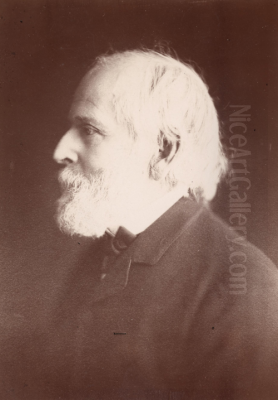
William Trost Richards stands as a significant figure in nineteenth-century American art, a painter whose meticulous dedication to capturing the natural world produced a body of work celebrated for its precision, detail, and profound connection to the landscapes and seascapes he observed. Born in Philadelphia in 1833 and passing away in Newport, Rhode Island, in 1905, Richards navigated the evolving artistic currents of his time, aligning himself initially with the Hudson River School before embracing the tenets of American Pre-Raphaelitism. His legacy rests on his extraordinary ability to render nature with almost photographic accuracy, combined with a subtle sensitivity to light and atmosphere, particularly evident in his renowned marine paintings.
Richards' journey was one of persistent observation and technical refinement. He eschewed the overt romanticism favored by some contemporaries, choosing instead a path of intense realism. Whether depicting the serene woodlands of Pennsylvania, the rugged peaks of the Adirondacks, or the dynamic energy of the Atlantic coast, his work consistently reflects a deep reverence for the intricate beauty of the natural environment. His mastery extended across both oil painting and watercolor, with his achievements in the latter medium marking him as one of America's foremost watercolorists of the era.
Early Life and Artistic Foundations
William Trost Richards' entry into the world of art was shaped by both innate talent and early necessity. Born in Philadelphia, a burgeoning cultural center, his formal schooling was cut short at the age of 13 following his father's death. To support his family, the young Richards found work designing ornamental metal fixtures, chandeliers, and gas fittings. This early experience in design likely honed his eye for detail and precision, skills that would become hallmarks of his later painting career.
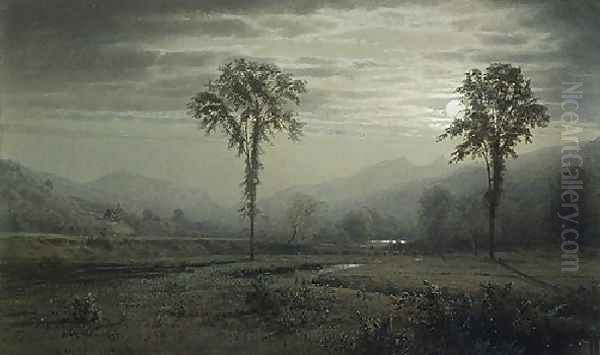
Despite these practical demands, Richards' artistic inclinations persisted. He pursued drawing and painting in his spare time, largely self-taught initially. A pivotal moment came when he sought formal instruction from Paul Weber, a German artist who had settled in Philadelphia. Weber, known for his detailed landscape style rooted in the Düsseldorf school tradition, imparted a meticulous technique and a disciplined approach to observation that resonated deeply with Richards' own temperament. This training provided a crucial foundation for his developing skills.
The allure of European art and landscapes beckoned, as it did for many aspiring American artists of the period. Between 1853 and 1856, Richards embarked on his first significant trip abroad. He traveled through England, France, Switzerland, Italy, and Germany, immersing himself in the masterpieces of European art and sketching the diverse scenery. His time spent in Florence, Rome, and Paris exposed him to both historical traditions and contemporary movements, broadening his artistic horizons and reinforcing his commitment to landscape painting.
Upon his return to the United States in 1856, Richards married Anna Matlack, a Quaker poet from Germantown, Pennsylvania. They settled in Germantown, and later in nearby Devon, establishing a home base from which Richards would launch numerous sketching expeditions. This period marked the beginning of his professional career in earnest, as he began exhibiting his work and gaining recognition within the Philadelphia art community. His family life provided stability, while his artistic pursuits continued to be fueled by an insatiable curiosity about the natural world.
The Hudson River School Connection
In the mid-nineteenth century, the dominant force in American landscape painting was the Hudson River School. This loosely affiliated group of artists, inspired by the writings of figures like Ralph Waldo Emerson and Henry David Thoreau, sought to capture the grandeur and spiritual essence of the American wilderness. Richards naturally gravitated towards this movement in his early career, sharing its members' profound appreciation for nature.
The first generation of Hudson River School painters, led by Thomas Cole and Asher B. Durand, established a tradition of detailed observation combined with a romantic sensibility. The second generation, flourishing around the time Richards began his career, included prominent artists such as Frederic Edwin Church, John Frederick Kensett, Albert Bierstadt, Sanford Robinson Gifford, and Jasper Francis Cropsey. These painters often traveled widely, seeking dramatic subjects from the Catskills and Adirondacks to the Rocky Mountains and South America, creating panoramic canvases filled with meticulous detail and often dramatic light effects.

Richards' early landscapes, depicting the familiar woods, fields, and streams of Pennsylvania and the nearby Adirondack Mountains, clearly show his affinity with the Hudson River School aesthetic. He shared their commitment to plein-air sketching as a basis for larger studio compositions and their focus on rendering natural forms with accuracy. Works from this period demonstrate his developing skill in capturing the textures of foliage, the structure of trees, and the play of light across the land.
However, even within the Hudson River School framework, Richards began to distinguish himself. While artists like Church and Bierstadt often emphasized the sublime and the spectacular, creating vast, awe-inspiring vistas, Richards often focused on more intimate scenes. His attention to botanical detail and geological formations hinted at a more scientific, analytical approach to nature, setting the stage for his later engagement with Pre-Raphaelite ideas. He admired the work of Church and Kensett but was already forging his own distinct path.
The Influence of Ruskin and the Pre-Raphaelites
A defining influence on William Trost Richards' artistic philosophy and style came from the writings of the English art critic and social thinker John Ruskin. Ruskin championed the idea of "Truth to Nature," urging artists to reject academic conventions and idealized formulas in favor of intense, unmediated observation and meticulous rendering of the natural world in all its complexity. He saw profound moral and spiritual value in this detailed fidelity.
Ruskin's ideas were famously embodied by the British Pre-Raphaelite Brotherhood (PRB), founded in 1848 by artists like Dante Gabriel Rossetti, John Everett Millais, and William Holman Hunt. While initially focused on reforming historical painting, their principles quickly extended to landscape, emphasizing bright colors, sharp focus, and an almost microscopic attention to detail, particularly in foreground elements like plants and rocks.
These ideas found fertile ground in America, leading to the formation of the Association for the Advancement of Truth in Art in 1863, often referred to as the American Pre-Raphaelite movement. Richards became associated with this group, which included artists like John William Hill, Henry Roderick Newman, and Charles Herbert Moore. They shared Ruskin's belief in the importance of detailed realism and saw nature as a source of divine revelation. Richards fully embraced the call for empirical accuracy, finding it aligned perfectly with his own inclinations.
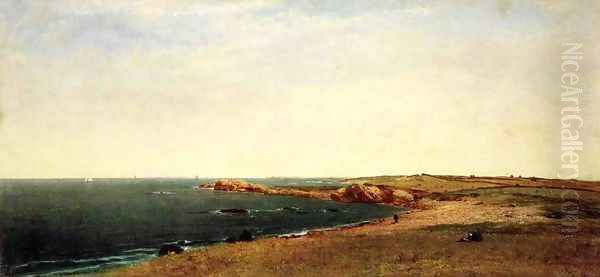
This influence is strikingly evident in Richards' work from the late 1850s and 1860s. His Plant Study (1860) is a prime example, showcasing an almost scientific precision in the depiction of leaves and flowers. His landscapes from this period often feature foregrounds rendered with extraordinary detail, inviting the viewer to examine individual blades of grass, pebbles, and leaves. This meticulous approach set him apart from many Hudson River School painters who might generalize such elements for broader effect. Richards believed that capturing these minute details was essential to conveying the true character of a place.
Richards' commitment to Pre-Raphaelite principles also involved a rejection of certain artistic conventions. He often avoided the hazy, atmospheric effects (sfumato) used by some landscape painters to create mood, preferring instead a clarity and sharpness of focus throughout the picture plane. He also began using photography, still a relatively new technology, as an aid to his observation, capturing details that could be studied later in the studio to ensure the utmost accuracy in his paintings. This dedication to empirical truth became a cornerstone of his artistic identity.
Mastery of Watercolor
While accomplished in oils, William Trost Richards achieved particular distinction in the medium of watercolor. During the latter half of the nineteenth century, watercolor painting gained increasing prominence in America, moving beyond its traditional role in preliminary sketches or amateur pursuits to become a respected medium for finished exhibition pieces. Richards was at the forefront of this development, recognized alongside artists like Winslow Homer as one of the country's leading watercolorists.
His approach to watercolor was characterized by the same precision and detail found in his oil paintings, but the transparency and fluidity of the medium allowed for unique effects of light and atmosphere. He often employed a technique of layering thin, transparent washes of color (glazing) to build up form and luminosity. This method allowed him to achieve remarkable subtlety in tonal gradations and capture the delicate nuances of light filtering through leaves or reflecting off water.
The 1870s were a particularly fruitful period for Richards' watercolor work. He produced a series of stunning views of the White Mountains in New Hampshire, works that were highly praised for their near-photographic realism and exquisite detail. Paintings like White Mountain Scenery (1873) exemplify his ability to render complex mountain terrain, atmospheric perspective, and intricate foreground elements with astonishing fidelity using the demanding watercolor medium.
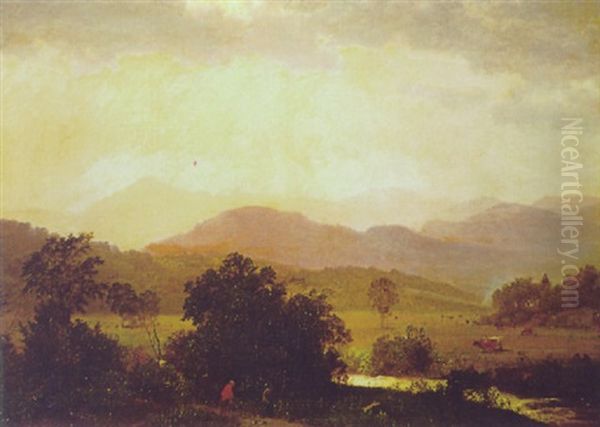
His coastal scenes in watercolor were equally celebrated. Works such as Beach Scene (1875) and Sunset, Trenton (1874) showcase his skill in depicting the textures of sand, the translucency of water, and the ephemeral effects of light at different times of day. His acclaimed watercolor Moonlight is often cited as a pinnacle of his achievement in the medium, demonstrating a masterful control over tone and atmosphere to evoke a sense of quiet mystery and beauty. Richards' technical virtuosity and his ability to elevate watercolor to the level of major exhibition art significantly contributed to the medium's rising status in American art.
The Lure of the Sea
Although initially known for his woodland and mountain landscapes, William Trost Richards developed an enduring fascination with the sea, becoming one of America's preeminent marine painters. This shift in focus intensified significantly after a trip to Great Britain in 1866-1867. Witnessing the power and majesty of the Atlantic along the British coasts profoundly impacted him, and marine subjects would dominate much of his later work.
He became particularly drawn to the dynamic interface between land and water – the rocky coastlines, sandy beaches, and the ceaseless motion of waves. Unlike some marine painters who focused on ship portraits or historical naval scenes, Richards concentrated on the natural drama of the sea itself. He spent countless hours observing and sketching the movement of water, the effects of light on its surface, and the geological formations of the shorelines he visited.
His marine paintings, whether in oil or watercolor, are characterized by their convincing depiction of wave action and their sensitivity to atmospheric conditions. He captured the translucency of breaking waves, the spray kicked up as water crashes against rocks, and the subtle shifts in color and light across the ocean's expanse under different skies. Works like Sunset over the Sea (1883) demonstrate his ability to combine detailed observation with a powerful sense of mood, conveying both the beauty and the immense power of the ocean.
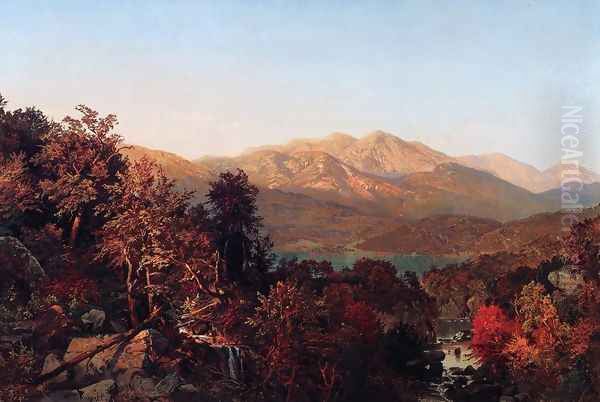
The coast of New England, particularly Rhode Island, became a favorite location. In 1874, he began spending summers in Newport, Rhode Island, captivated by its rugged coastline. In 1881, he purchased land on Conanicut Island, across the bay from Newport, and built a substantial summer home and studio he named "Graycliff." This location provided him with constant inspiration, and many of his finest marine paintings depict the shores and waters around Narragansett Bay. Richards' Home on Conanicut Island (1882) offers a glimpse into this important phase of his life and work. His focus on the American coast aligned him with contemporaries like Alfred Thompson Bricher, though Richards' style often maintained a more rigorous, Pre-Raphaelite detail. While different in style, his dedication to marine subjects echoes the lifelong engagement of Winslow Homer with the sea. Some critics also note a possible awareness of the dramatic marine paintings of the British master J.M.W. Turner, particularly in the handling of light and atmosphere.
Later Life and Continued Exploration
Throughout his mature career, William Trost Richards maintained his rigorous work ethic and his commitment to direct observation of nature. Even after establishing himself as a leading painter, he continued to undertake sketching trips, seeking out new subjects and refining his understanding of landscape and marine environments. His travels were not limited to the American Northeast; he made several subsequent trips to Europe, visiting England, Scotland, and Ireland, drawn particularly to their dramatic coastlines which offered parallels and contrasts to his familiar New England shores.
His family life remained closely intertwined with his artistic practice. His daughter, Anna Richards Brewster, also became an artist and writer, and she often accompanied her father on his travels, documenting their experiences. This close familial bond provided both personal support and companionship during his extensive periods of work away from home. The family spent winters primarily in Pennsylvania, often at their home "Oldmixon" near Philadelphia, while summers were dedicated to the coastal environment of Newport and Conanicut Island.
Richards remained active as an artist until the end of his life. He continued to exhibit his work regularly at prestigious venues such as the National Academy of Design in New York (where he had been elected an honorary member in 1862), the Pennsylvania Academy of the Fine Arts in Philadelphia, and even internationally, including exhibitions at the Royal Academy in London. He received numerous accolades, including a medal at the Centennial Exposition in Philadelphia in 1876, recognizing his exceptional skill, particularly in marine painting.
Despite the rise of newer artistic styles like Impressionism towards the end of the nineteenth century, Richards largely remained steadfast in his commitment to detailed realism. While some critics began to favor looser brushwork and more subjective interpretations of nature, Richards continued to believe in the power and importance of meticulous observation and precise rendering. He passed away in Newport, Rhode Island, in 1905, leaving behind a substantial and highly accomplished body of work.
Critical Reception and Enduring Legacy
William Trost Richards enjoyed considerable success and recognition during his lifetime. His technical skill was widely admired, and his works were sought after by collectors and acquired by major institutions. Critics praised his ability to capture the intricate details of nature with unparalleled accuracy, often describing his paintings as possessing a "photographic" or "mirror-like" quality, intended as high compliments in an era that valued verisimilitude. His contributions to both landscape and marine painting, as well as his mastery of watercolor, secured his place among the leading American artists of his generation.
However, his unwavering adherence to meticulous realism also drew some criticism, particularly later in his career as artistic tastes began to shift. Some commentators felt his intense focus on detail could occasionally lead to works that felt overly laborious or lacked a sense of spontaneity and broader atmospheric unity. The very precision that many admired was seen by others as potentially sacrificing emotional expression or compositional dynamism. His time-consuming technique also meant his output, while substantial, was perhaps less prolific than that of artists employing looser styles.
Despite these occasional critiques, Richards' reputation has endured and arguably grown in the decades since his death. Art historians recognize his crucial role within the American Pre-Raphaelite movement and his unique position bridging the detailed aesthetic of the Hudson River School with a more scientifically informed naturalism. His works are now held in the permanent collections of virtually every major American art museum, including the Metropolitan Museum of Art in New York, the National Gallery of Art in Washington, D.C., the Museum of Fine Arts, Boston, the Philadelphia Museum of Art, the Pennsylvania Academy of the Fine Arts, and the Yale University Art Gallery.
His paintings continue to command strong prices at auction, reflecting sustained interest from collectors. Exhibitions dedicated to his work reaffirm his technical brilliance and the enduring appeal of his carefully observed depictions of the American landscape and coastline. Richards' legacy lies in his unwavering dedication to "Truth to Nature," his exceptional technical proficiency in both oil and watercolor, and his creation of a body of work that captures the specific character of the American environment with remarkable clarity and reverence. He remains a testament to the power of close observation and meticulous craftsmanship in the pursuit of artistic expression.
Conclusion
William Trost Richards carved a unique and significant niche in the landscape of nineteenth-century American art. From his early training in Philadelphia and formative travels in Europe, he developed a style rooted in careful observation and technical precision. While initially aligned with the Hudson River School, his deep engagement with the ideas of John Ruskin and the Pre-Raphaelite movement led him to pursue an even more rigorous realism, capturing the intricate details of the natural world with extraordinary fidelity.
His mastery extended across both landscape and marine subjects, and he achieved particular renown for his luminous and detailed watercolors, becoming a key figure in the elevation of that medium in America. His fascination with the Atlantic coast, especially the shores of New England, resulted in a powerful body of marine paintings that capture the dynamic energy and subtle beauty of the sea. Though steadfast in his detailed style even as newer artistic trends emerged, Richards' dedication to his vision earned him widespread acclaim during his lifetime.
Today, William Trost Richards is remembered as a master technician and a profoundly sensitive observer of nature. His works offer a window onto the American landscape and seascape of his time, rendered with a clarity and precision that continues to captivate viewers. His legacy endures in the major museum collections that house his paintings and in the ongoing appreciation for his unique contribution to the American realist tradition. He remains a compelling example of an artist deeply committed to exploring and representing the truth he found in the natural world.